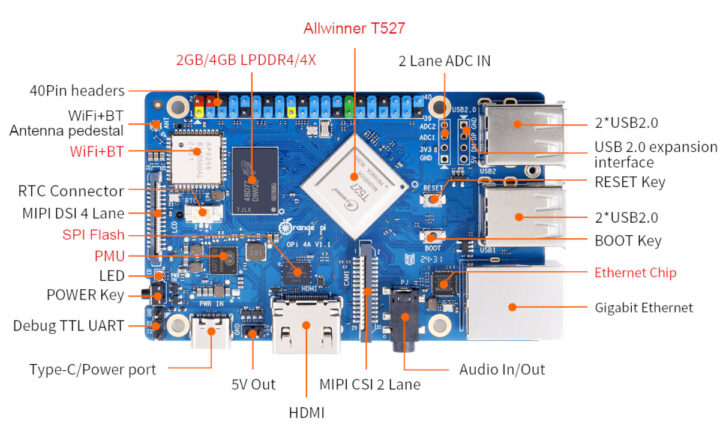Orange Pi 4A is a new low-cost credit card-size single board computer (SBC) powered by an Allwinner T527 octa-core Cortex-A55 processor with a 2TOP NPU and offered with either 2GB or 4GB RAM.
The board also comes with multiple storage options: a 128 or 256Mbit SPI NOR flash for the bootloader, an eMMC socket for up to 128GB modules, an M.2 socket for NVMe SSDs, and a microSD card slot. It’s also equipped with four USB 2.0 ports, a gigabit Ethernet port, three display interfaces (HDMI, MIPI DSI, eDP), two camera interfaces, and a 40-pin “Raspberry Pi” header. The Orange Pi 4A is somewhat equivalent to an octa-core Raspberry Pi 3/4 with some extra features.
Orange Pi 4A specifications:
- SoC – Allwinner T527
- CPU
- Octa-core Arm Cortex-A55 @ up to 1.8GHz (four cores) and up to 1.42 GHz (four cores)
- XuanTie E906 RISC-V core @ 200MHz
- GPU – Arm Mali-G57 MC1
- VPU – H.265 4Kp60 decoding, H.264 4Kp60 decoding, H.264 4Kp25 encoding
- AI accelerator – 2 TOPS NPU
- Audio DSP – HIFI4 @ 600MHz
- CPU
- System Memory – 2GB or 4GB LPDDR4/4X
- Storage
- 128Mbit SPI flash by default, option for 256Mbit
- eMMC socket for modules with 16GB, 32GB, 64GB, or 128GB capacity
- M.2 M-Key (PCIe 2.0) socket for NVMe SSD
- MicroSD card slot
- Video Output
- HDMI 2.0 up to 4Kp60
- 4-lane MIPI-DSI connector
- eDP 1.3 connector
- Audio
- 3.5mm headphone jack audio input/output
- Digital audio output via HDMI
- Camera
- 2-lane MIPI-CSI camera interface
- 4-lane MIPI-CSI camera interface
- Networking
- Gigabit Ethernet port
- Wi-Fi 5.0 and Bluetooth 5.0 LE via Ampak AP6256 module
- USB
- 4x USB Type-A 2.0 ports including one (top left) used for firmware flashing
- 4-pin header (unpopulated) with USB 2.0 for expansion
- Expansion
- 40-pin color-coded Raspberry Pi-compatible GPIO header with GPIO, UART, I2C, SPI, PWM
- 4-pin ADC connector for 2x ADC up to 1.8V input
- Debugging – 3-pin serial debug header
- Misc
- Boot, Reset, Power buttons
- Power LED
- 2-pin battery connector for RTC
- Power Supply
- 5V/5A input via USB-C port
- 2-pin 5V output header
- Dimensions – 89 x 56 mm
- Weight – 52 grams

Orange Pi says the 4A SBC supports Ubuntu, Debian, and Android 13. The documentation is still a work in progress as while there are links to a user manual, schematics, tools, OS images, and SDKs/source code hosted on Google Drive all those are empty. We were told the Orange Pi 4A would get mainline Linux support at the Orange Pi Developer Conference 2024, but I can’t find any reference to T527 in recent Linux changelogs, and only a minor change for A523 (its tablet equivalent) in Linux 6.11.
Having said that, it’s not the first Allwinner T527 SBC we’ve covered as the Avaota A1 open-source hardware SBC was introduced in April 2024 and ran/booted Linux 6.6 at the time. MYiR Tech also launched an Allwinner T527 system-on-module that was eventually integrated into a digital signage/smart display board, and Boardcon has its own SoM and devkit based on the processor..
Official pricing for the Orange Pi 4A is $35 for the 2GB RAM version and $40 for the 4GB RAM variant. Provided the software works, that’s pretty good value considering the features offered. The Allwinner T527 SBC 2GB RAM and 4GB RAM models are listed on Amazon without pricing, but you can also purchase the board on AliExpress for the stated prices plus shipping and taxes if any.

Jean-Luc started CNX Software in 2010 as a part-time endeavor, before quitting his job as a software engineering manager, and starting to write daily news, and reviews full time later in 2011.
Support CNX Software! Donate via cryptocurrencies, become a Patron on Patreon, or purchase goods on Amazon or Aliexpress







